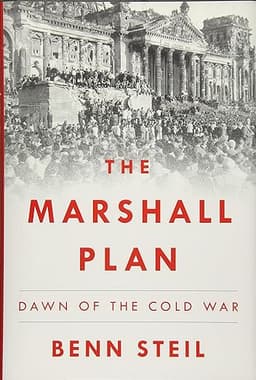
Book Review
The Marshall Plan: Dawn of the Cold War, 2021
By Ben Steil
Buy the book: https://global.oup.com/academic/product/the-marshall-plan-9780192843104?lang=en&cc=es
Benn Steil’s character-driven depiction of the development, implementation and aftermath of the Marshall Plan is informative and entertaining. Steil takes the reader through the initial crisis that created the need for the Marshall Plan to its eventual success and ramifications. The book clearly lays out the political and economic environment in which the Marshall Plan was developed.
Following WWII, the pressures on Germany to provide reparations to Stalin’s Soviet Union starkly contrasted with the US’s approach to build up Germany for a united Europe to combat encroaching communism. Steil’s narrative outlines the success of the Marshall Plan in bolstering the economic recovery in Europe through Keynesian economic policies in developing the Europe we have today. He brings the reader up to the fall of the Berlin Wall and the establishment of NATO. Given our current political and economic environment with Putin’s war on Ukraine and the expansion of NATO, this book is timely and truly informative for anyone studying the history of business.
The approach that Steil takes is to present the political and economic environment created by the actors who crafted the Marshall Plan, such as George Catlett Marshall to George Frost Kennan to Mikhailovich Vyacheslav Molotov. The character narrative continues into the Post-Cold-War period, presenting the views of George Bush and Helmut Kohl along with Reagan and Gorbachev. Steil goes so far as to provide an extensive list of characters at the end of the book with substantial details on each person’s history. The motivations behind the development of the Marshall Plan and the political maneuvering to ensure its success are depicted in great detail, from the copious research conducted by the author. The reader feels as if they are dropped into the various meetings on the Marshall Plan held by key actors as they discuss its nature and what implementing it means for their countries and ideologies.
That Steil has conducted a significant amount of archival research in writing this book can be found throughout the narrative and in the numerous appendices. Both Truman’s Doctrine Speech and Marshall’s Harvard Speech are provided in appendices along with macro-economic data for all the countries involved from 1946 to 1955. Various maps provide the reader with a clear understanding of the geopolitical nature of the Marshall Plan. Steil has examined peer-reviewed papers, news articles, government reports and bills to provide the evidence for each discussion point presented. He provides the reader with a solid grounding in understanding the scope and scale of the Marshall Plan’s influence on political and economic history.
It is in the character-driven nature of the narrative presenting the political and economic history of the Marshall Plan that business history scholars may find outside their scope of interest. The reader is introduced to the ideological conflict between Truman’s United States and Stalin’s Soviet Russia as the key drivers of the development of the Marshall Plan. The details presented on the conflict between capitalism and communism that affected the development of Germany, Europe and the US are fascinating. The book does not directly discuss business history and the challenges or opportunities that come from the Marshall Plan’s development and implementation. Steil’s book is meant to provide the reader with an understanding of the political and economic history of why the Marshall Plan was created and the political and economic outcomes that resulted from it.
The 404 pages of text that Steil lays out present exactly what the author intended, a detailed analysis of the development, implementation, and political and economic outcomes of the Marshall Plan. The additional 53 pages of character lists and appendices provides the reader with ample detail to understand the geopolitical nature of the Marshall Plan and who was involved in its development and implementation. The ideological struggles between the US and the Soviet Union presented by Steil can be seen today as Putin attempts to expand Russia’s influence and destabilize western institutions such as NATO.
Dr. Simon Berge
Dalhousie University